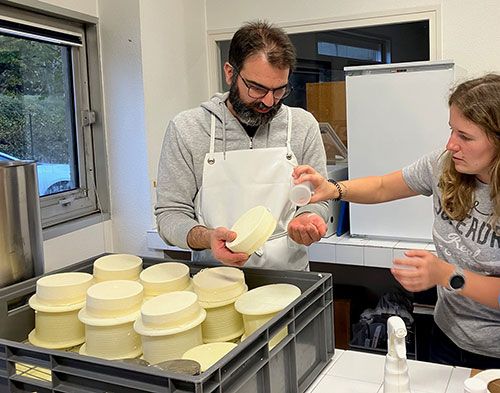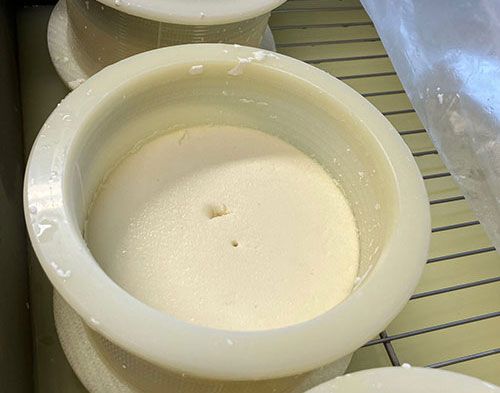
Making cheese to study health risks
Several teams from ANSES are going to make cheese in a laboratory, in order to study the risk of pathogenic organisms being transmitted via cheese consumption. This will be a complex task, due to the precautions that will need to be taken to avoid any external contamination by the micro-organisms under study.
ANSES’s scientists have learned to make cheese and are planning to do so in a laboratory setting, not because they share a passion for food but rather for the purposes of their research: two projects have been launched in recent months dealing with the risk of pathogenic micro-organisms being transmitted from animals to humans via cheese consumption.
TBEV: understanding the differences between goat's milk and cow's milk cheeses
A project was launched in September 2022 to study tick-borne encephalitis virus (TBEV). In 2020, 43 people had been infected with this virus in the Ain département of France after eating goat cheese made with raw milk. These were the first cases of the virus being transmitted through food in France. “All animals can be carriers of TBEV and excrete it in their milk, but up to now, most of the reported cases of contamination following the consumption of cheese have involved goat cheese. We want to understand why” explains Sandrine Lacour, a project manager in the Virology joint research unit of ANSES’s Laboratory for Animal Health. The scientist is considering several hypotheses. The first is that these differences are related to production conditions: some cow’s milk cheeses, for example, include a heating phase in their production process, which could prevent the virus from surviving. The pH, level of humidity and salt content can also vary and influence the persistence of the virus. The scientist therefore plans to test the effects of the preparation conditions. “If, using the same production process, we still observe differences between goat's milk, cow's milk and sheep's milk cheeses, this will mean these differences are due to the composition of the milk” she predicts. Indeed, the milk of these various species does not have the same fat, protein or vitamin content. In addition, specific cells may be present in goat’s milk that are absent from the milk of other animals, which could promote the survival of the virus.
Brucella melitensis: assessing the risk of Reblochon cheese becoming contaminated

Another three-year project was initiated in October. It is focusing on the risk of Reblochon cheese becoming contaminated by Brucella melitensis, the bacterium responsible for human brucellosis. “For the moment, we have no evidence that the bacterium can persist in cheese” explains Luca Freddi, a project manager in the Bacterial Zoonoses unit of ANSES’s Laboratory for Animal Health. “We know that milk can be contaminated, but we haven’t managed to detect Brucella melitensis in Reblochon cheese. This doesn’t mean that it isn’t present and that there is no risk of contamination. A very small amount of Brucella is enough to make someone ill, and we know that if it is present, it will be difficult to find it among the multitude of bacteria contained in a cheese!” When an outbreak of brucellosis was declared on a cattle farm in the Haute-Savoie département of France in 2021, over 5,500 tonnes of Reblochon cheese had to be recalled as a safety measure. Reblochon cheese has several characteristics that could promote the survival of the bacterium: it is made from raw milk, it matures for a relatively short period of time, and the acidity and temperature conditions during production do not guarantee that the micro-organism is eliminated. The aims of the project are therefore to determine whether there is a real risk of contamination and, if there is, to develop a test capable of detecting the bacterium in Reblochon cheese.
Highly secure laboratory conditions

To understand the risks of contamination and issue recommendations to avoid them, the two research teams are going to make cheese from artificially contaminated milk. They will be faced with the same difficulty: because the micro-organisms in question can be transmitted to humans, the cheeses will have to be made in containment laboratories that meet P3 biosafety standards. “These conditions aren’t comparable to the factories where cheeses are usually made, so we have had to adapt” affirms Sandrine Lacour, who has started making goat cheese from uncontaminated milk to test the preparation conditions. “For example, I work in a ventilated safety cabinet with a small 20-centimetre opening. There’s room for me to put my arms through it, but the pot in which the cheese is made doesn’t fit! So we had to dismantle the cabinet to put all the utensils inside” she explains. As the room is also used for other microbiological work, it will not be possible to mature the cheese with yeast, to avoid contaminating the other processes. “I’m going to make cheese with lactic starters only, which will still enable us to test a number of hypotheses”.
As far as Reblochon cheese is concerned, there is no question of modifying the production process for the purposes of the experiment: the “Reblochon” designation is based on a very specific recipe. A great deal of preparatory work will therefore be undertaken to identify the stages most at risk of spreading the Brucella bacterium within the laboratory and find solutions to keep this from happening. “We already know that stirring and heating the milk will be two critical stages where there is a risk of the bacterium becoming airborne. It will also be necessary to prevent any potential spillage or leaks, and to dispose of all waste” explains Claire Ponsart, head of the Bacterial Zoonoses unit. For this project, the scientists are working with the Actalia centre of expertise for the food industry, which will design a dedicated piece of equipment, i.e. a sort of “multi-tier pot” in which small Reblochon cheeses can be made in complete safety.